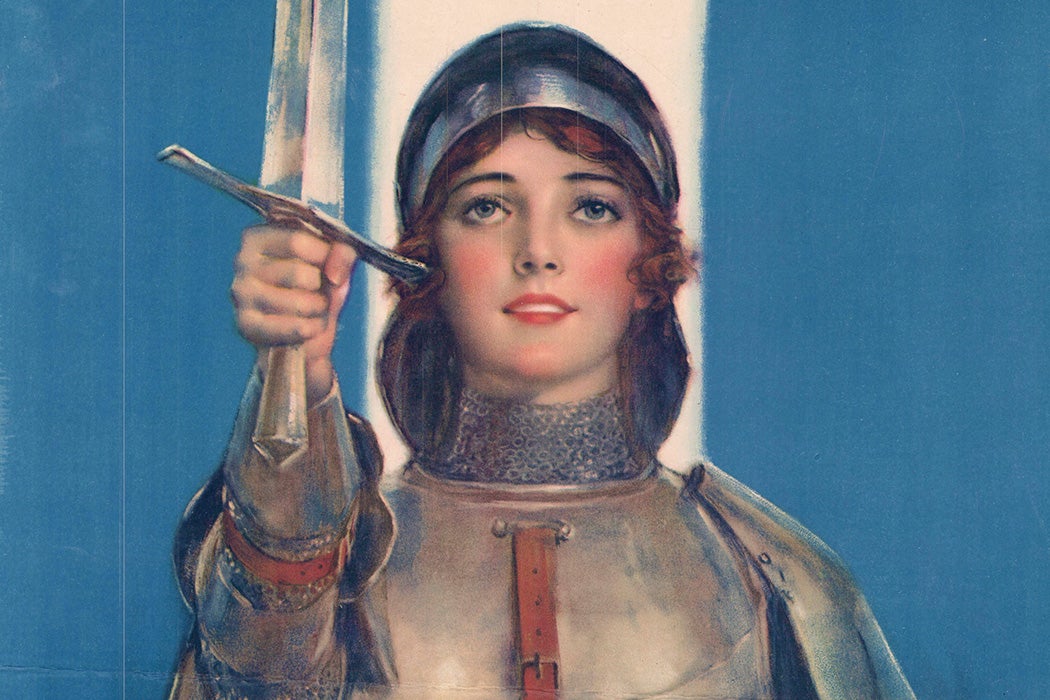A minor irony of 1920 was that the Roman Catholic church canonized a teenage peasant girl it had burned back in 1431. This was the short-haired, armor-plated, sword-wielding, horse-riding, saint-voice-hearing, to-victory-leading Joan of Arc, French heroine of the Hundred Years War. The church deemed her a heretic, so the martyring proceeded. (She was posthumously declared innocent in 1456.)
Today, Joan of Arc is one of the patron saints of France, but that’s not all. Within France, she is also a symbol of reactionary nationalism, venerated by the Far Right long before she was canonized. Outside France, though, Joan has been more of a heroine of feminism and androgyny, especially in Britain and the United States.
So how did the late-medieval heretic turn into two very different symbols in modern times? Scholars suggest that to answer that question, you need to understand first how proto-fascist elements tried to undermine the democratic government and promote a “true” France—one without Jews, immigrants, or academics. Second, during World War I, there was a strong appetite in France and among its allies for a figure symbolizing an unlikely commander of a beaten-down army who won; the fact that Joan was a woman showed that strength and power didn’t belong only to men.
When she was just a graduate student, historian Martha Hanna published an influential essay looking at why the extreme-right group Action française venerated St. Joan. Although she had been emerging as a nationalist hero among poets since the early nineteenth century, she became especially important to Action française, who wanted to smash the secular government of the Third Republic and bring back the French monarchy. They promoted St. Joan’s feast day as a reactionary alternative to Bastille Day and rewarded young thugs who beat up secular academics with prizes named after her.
Changes came with the outbreak of World War I. Joan of Arc’s patriotic popularity inside France took off, and not just on the right; republicans who’d been suspicious of her cult embraced her too. By the time she was canonized, Action française was being eclipsed by other proto-fascist groups. New right-wing movements, however, would repeatedly use Joan as a symbol of purity, Catholicism, and “Frenchness.”
Meanwhile, Joan was blowing up among secular figures outside France as a symbol of transgressive female power. In one war poster, American women were urged to emulate Joan and lead their country to victory—by buying war stamps. But it was in the arts that Joan’s image as an ambiguously gendered warrior solidified. Cecil B. DeMille directed a 1916 silent film epic about her, Joan the Woman. She was also the protagonist of George Bernard Shaw’s feminist play of 1926, Saint Joan, and a Berthold Brecht drama with the proletarian title Saint Joan of the Stockyards.
Around the time she was canonized, in fact, suffrage activists even mounted elaborate parades featuring costumed equestrian “Joans.”
The literary scholar Karyn Z. Sproles focuses on one example of the secular, feminist Joan of Arc: a 1936 biography by the acclaimed Bloomsbury author, frequent cross-dresser, and Virginia Woolf lover, Vita Sackville-West.
Sproles argues that Sackville-West was a scrupulous researcher of Joan’s life but interpreted the saint in terms she could relate to herself: She saw Joan “not as a saint or a visionary, but as an active woman who led the life of a man without becoming male.” In other words, Joan foreshadowed the modern, independent woman by a good six centuries.
Weekly Newsletter
Sackville-West, according to Sproles, was fascinated with the way Joan wore the masculine armor of a warrior, noting that Sackville-West herself would often don men’s clothing and call herself by a man’s name to flirt and dance with (and seduce) other women. In the biography, Sproles argues, Sackville-West also loses sight of Joan’s power as a religious figure who heard the voices of saints as she focuses on Joan’s dress and androgyny.
Vita Sackville-West wasn’t the only secular feminist who took Joan of Arc as inspiration, of course. But now, as Catholics mark the centennial of Joan’s canonization, it’s clear that there is more than one Joan of Arc, who does not belong exclusively to the church or to France at all.







